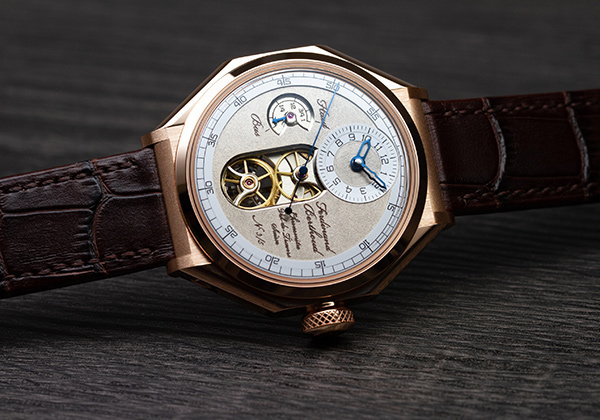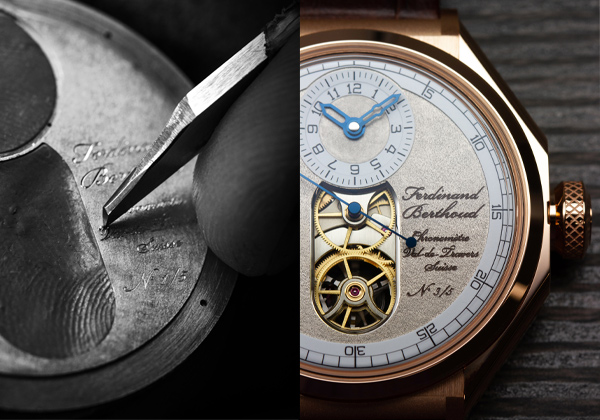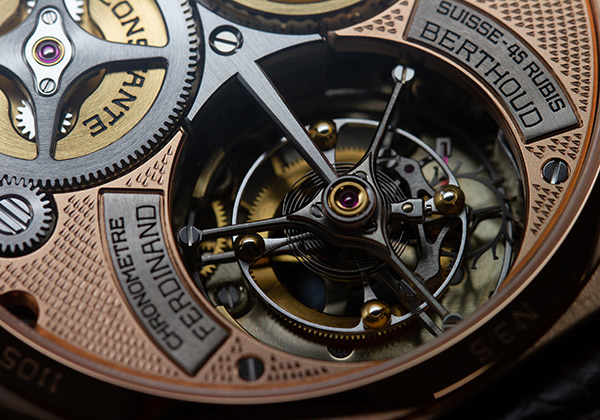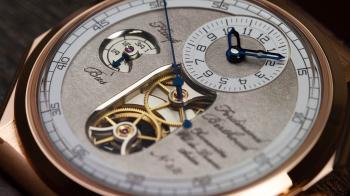At the last Salon International de la Haute Horlogerie (SIHH), Ferdinand Berthoud exhibited its new creations, inspired by the brand's Astronomical Pocket Watch No. 3, which expand the FB 1 collection: the Œuvres d'or. On the occasion of the Salón Internacional Alta Relojería México (SIAR) 2019, which takes place from 15 to 17 October 2019 in Mexico City, Ferdinand Berthoud presents the FB 1.2-3 "Œuvre d'or", consisting of an 18-carat white gold dial entirely hand-patinated and an 18-carat pink gold case as well. This five-piece limited edition watch completes the two other series introduced at the 2019 SIHH, which also include five pieces each. The limited number of pieces allows the company to give more time for each piece, highlighting its handmade aspect.

Handmade dial
The white gold dial reflects the traditional techniques used. This one is entirely hand-patinated. First, the gold is carefully grained with a graver, then the resulting surface is crafted with a tool called a "rocker", which smoothes it so that the grains are as invisible as possible in order for the light to slide across the dial. The shine effect is therefore minimized, so the watch retains its discretion, thanks to the work done by hand. On the right of the dial are engraved by hand the descriptive indications of this creation as well as its number because, let us remember, it is limited to five pieces: "Ferdinand Berthoud - Chronomètre Val-de-Travers - Suisse" and "N° X / 5". On the left side is the power reserve of the movement. The gold hour and minute dial is off-centre and is located on the upper part of the main dial.

Three unique points movement
The heart of this creation contains a FB-T.FC-3 calibre with three 18-carat rose gold half-bridges. This one, certified COSC (Swiss Official Chronometer Control), has three essential specificities. First, the fusée-and-chain transmission system allows a constancy in the energy transmitted by the barrel. Indeed, in order to guarantee a constant couple, a chain runs around a cone-shaped element, the fusée. When the barrel delivers the maximum of its power, the chain is positioned on the top of the fusée (part of the cone where the circumference is the smallest). As the power decreases, this chain unfolds to the base of the rocket, so it remains tense and the delivered force remains constant. This mechanism is one of the key elements of the brand's timepieces and Ferdinand Berthoud is one of the few that systematically uses it compared to the rest of the industry, which has turned to less expensive and less bulky solutions thanks to improvements in the exhaust system. Ferdinand Berthoud, being specialized in chronometers, naturally attaches great importance to the fusée-and-chain because it improves the chronometric positions of its creations. Secondly, in the centre, a tourbillon with a direct-drive seconds appears. It makes it possible to cope with energy variations produced by the different positions to which the timepiece is subjected to on a daily basis; in other words, this complication improves the precision of the watch. The correlation between the driving wheel of the tourbillon carriage and the fourth wheel (visible on the dial side) allows the existence of the direct-drive seconds. Thirdly and lastly, the operation of the operating indicator is unique. Indeed, its operation is based on a moving cone rising and falling according to the arming level (power level) of the part in relation to the rotation of the barrel. This hand-wound mechanical movement has a frequency of 21,600 Alt/h (3 Hz) and a power reserve of 53 hours.

Modern case that lets light in
The case, which is water-resistant to 30 metres and entirely made of 18-carat (5N) rose gold, takes its shape from the octagon, allowing it to stand out. The use of pink gold creates a contrast with other types of gold. While white and yellow gold evoke a classic image, pink gold modernises the watch since the material has experienced a boom and much trendier over the past twenty years. Moreover, it is more discreet than a flashy yellow gold, which fits the spirit of this timepiece. A diameter of 44 mm and a thickness of 13 mm structure this case. This one has been designed so that light enters and its functioning is, therefore, easily visible. In the same way as the dial side, the sapphire crystal back shows the movement of the FB 1.2-3, but this time with higher visibility. In addition, an extra light source has been added to the timepiece: on the sides of the case, four sapphire openings have been created to further illuminate the complex and interesting workings of this "oeuvre d’or". Like the dial, the movement also demonstrates the techniques done by hand. Indeed, on the three half-bridges visible through the sapphire back, it is possible to contemplate the "pyramid" motif, created with a graver by the manufacturer's careful hands. The regularity of this motif, done by freehand, reveals the great mastery of the engravers of the house.

Elegance from A to Z
This watchmaking creation by Ferdinand Berthoud is elegantly paired with a hand-stitched rolled-edge brown alligator leather strap and is accompanied by an 18-carat pink gold pin buckle that subtly completes the entire watch.
The aesthetics of this timepiece, resolutely contemporary because of the materials used, is oriented towards detail, made possible thanks to the hands that made it. Despite the great techniques used, this creation remains sober and discreet, achieving that goal to perfection.
This 263'500 CHF-"oeuvre d’or" is, truly, a piece of golden art.





